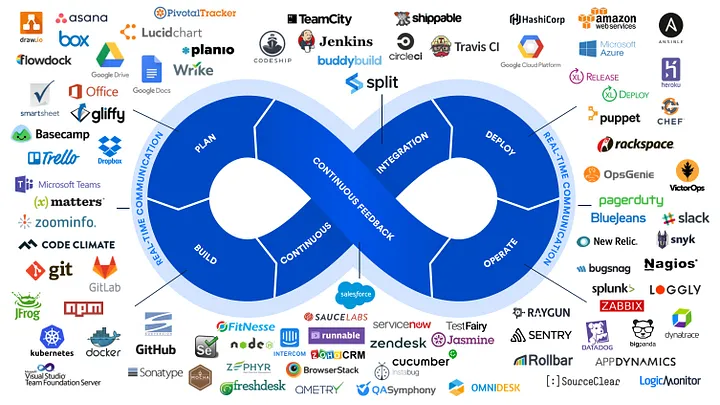DevOps - Values, Tools, and the Path to Efficient Software Delivery
DevOps is more than a set of processes; it’s a comprehensive approach to software development and operations that emphasizes collaboration, automation, and cultural alignment. By integrating these principles, DevOps provides organizations with the tools to streamline workflows and enhance the quality of software delivery. This blog will discuss the values DevOps brings, the essential tools in its toolkit, and the stages of maturity that guide organizations toward achieving an optimized DevOps environment.
Core Values of DevOps
The foundation of DevOps lies in two main aspects: culture and tools. These elements foster an environment where team collaboration, process automation, and continuous improvement thrive.
DevOps Culture
A successful DevOps culture promotes:
- Collaboration and Communication: Breaking down silos between development and operations teams is critical. Teams must share responsibilities, enhancing understanding of how their roles contribute to overall software quality.
- Autonomous Teams and Shared Responsibility: Each team takes ownership of their segment within the development pipeline, emphasizing quality and accountability.
- Agile Values in Practice: DevOps incorporates agile principles, with progress measured by delivering functional software directly to customers.
To maintain this culture, teams must also adopt agile practices, continuously integrating and deploying small code changes to improve agility and responsiveness【42†source】.
DevOps Tools
Effective DevOps requires a robust set of tools to facilitate configuration management, automation, and monitoring throughout the delivery pipeline. Automation tools in DevOps help streamline processes, enabling teams to move up the DevOps maturity chain, which consists of continuous integration, continuous delivery, and, at the highest level, continuous deployment.
Essential Tools in DevOps
DevOps relies on specific tools designed to optimize each stage of the software delivery lifecycle. Here’s a look at the main categories of DevOps tools and examples for each:
These tools enable organizations to automate and standardize workflows, critical steps for maturing along the DevOps path【43†source】.
Phases of DevOps Maturity
The journey to a mature DevOps environment is incremental, typically evolving through these stages:
Waterfall Development: Traditionally, development teams worked in long cycles with minimal collaboration. Integration was infrequent and often resulted in significant delays.
Continuous Integration (CI): In CI, code is integrated into a shared repository multiple times daily, significantly reducing integration issues. CI is foundational to DevOps and relies heavily on automated testing.
Continuous Delivery (CD): Building on CI, CD ensures that the code is consistently in a deployable state, minimizing manual intervention. CD practices include automated testing and staging, readying the application for release at any time.
Continuous Deployment: The final stage in DevOps maturity, continuous deployment, is where code changes are automatically tested and released to production without manual oversight. Only organizations with advanced DevOps implementations, such as Netflix and Amazon, typically operate at this level【33†source】【27†source】.
DevOps embodies a philosophy that merges people, processes, and technology to improve the quality and speed of software delivery. By adopting DevOps values and leveraging essential tools, organizations can enhance team collaboration, streamline operations, and achieve faster release cycles. Each phase of DevOps maturity—continuous integration, continuous delivery, and continuous deployment—brings organizations closer to a highly efficient, automated workflow.
In a world where innovation and agility are critical, DevOps provides a proven framework for organizations to transform their software delivery practices, fostering resilience, responsiveness, and a culture of continuous improvement.





